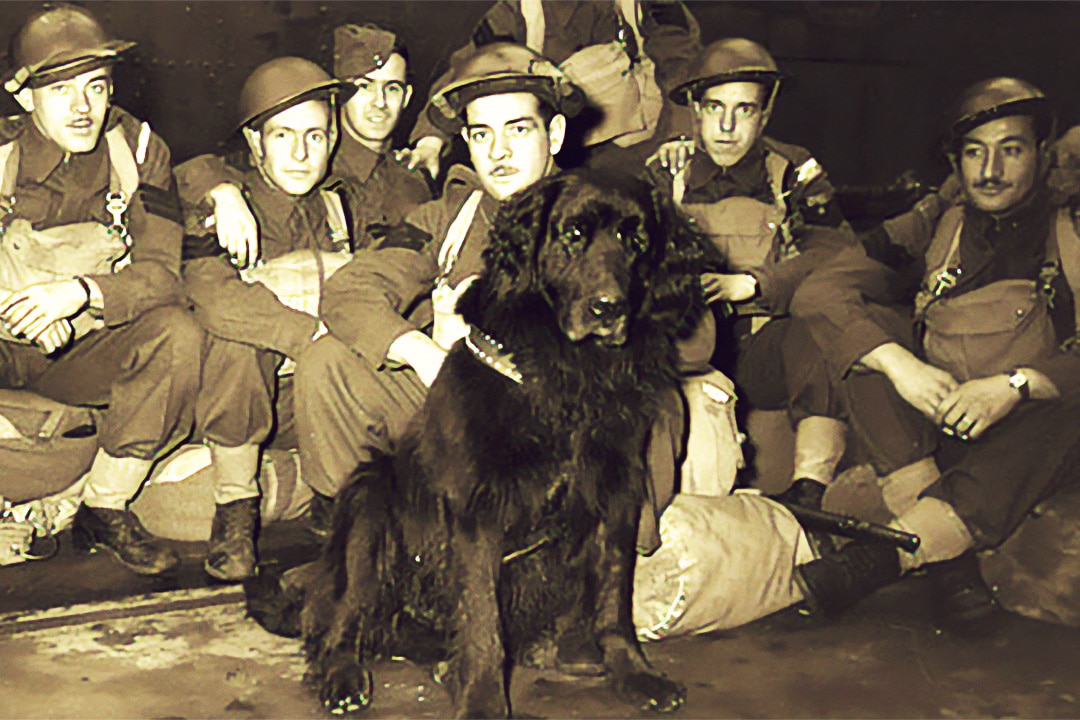Sergeant Gander
This is a story of war. A story of a canine hero whose devotion was not recognised for decades, who, in a single action, in the height of battle, saved the lives of seven soldiers. It is also a story of sacrifice.
The Dickin Medal: Often referred to as the animals’ Victoria Cross.
If you are having a bad day or will be upset, give this one a miss.
He started life as a pet of the Hayden family and was called Pal. The family lived in Gander, Newfoundland, Canada and being a very playful Newfoundland dog weighing in at around 130 lbs, Pal became a great favourite with the local children. Unfortunately, during a session, he scratched the face of a 6-year-old girl, which required the attention of a doctor. Facing the prospect of the Haydens having to have Pal euthanised, the Haydens offered him to the Ist Battalion Royal Rifles of Canada, where he became their mascot and was renamed Gander.
To legitimise his status as a soldier, he was given a number and a kit bag that included his brush and feeding bowls; he also drew rations, which were really necessary as he was a large fellow and naturally consumed large meals. The men built him a state-of-the-art kennel; however, Gander was not happy and cried and barked when left outside. To get a good night’s sleep, the troops relented, and from then on, he lived in barracks with the men.
Defending Hong Kong
Having been posted to defend Hong Kong, the men decided against leaving him behind, promoted him to the rank of sergeant and set sail with their mascot. The insignia of his rank was etched onto his collar. His handler, one Fred Kelly, would often share a shower with the dog as Gander needed to stay cool in the oppressive heat. It is also reported that Gander enjoyed an occasional pint of beer. Not a good addition to his diet, but in those days, they did not have the dangers of alcohol to canines. Not that it would probably have made any difference. It needs to be understood that the men didn’t see Gander as just a dog; he was one of them. This was similar to the way Squadron Leader Guy Gibson VC treated his dog. (See Guy Gibson’s Dog) Giving a pint of beer to the mascot was part of the behaviour of servicemen at the time.
December 8th 1941, was the start of the Battle of Hong Kong.
What occurred then would not happen now. A regimental mascot running loose around a battlefield would have the animal rights brigade in apoplexy, but as we have seen before, it was a different world.
Roaming the battlefield
As the men of the Royal Rifles engaged the enemy, Gander was left free to roam around the battlefield, where he had his own rather unique contribution. Bearing in mind that a lot of this engagement took place at night, Gander would charge at enemy soldiers, knocking them to the ground and biting them. Captured Japanese would tell tales of a large “Black Beast” that they referred to as a black devil attacking them, believing that the Canadians had trained these animals to attack enemy soldiers. Thinking about it, it must have been terrifying to suddenly be confronted, at night, by a huge black animal growling and biting.
On December 18th, in a lull in the fighting, seven wounded men lay close to each other when suddenly a grenade landed close by. Because of their injuries, none of the injured soldiers could react swiftly enough, and death awaited within seconds. Gander instantly appeared, retrieved the grenade and ran toward the enemy. The consequences were inevitable. There is no evidence that Gander had ever retrieved anything before this incident.
Recognition
On October 27th 2000, 60 years after the event, Gander was awarded the Dickin Medal, the first to be awarded since 1949. The ceremony was attended by 20 survivors of the regiment, including Fred Kelly, who accepted the medal on Gander’s behalf.
His medal is displayed at the Canadian War Museum in Ottawa, and his name is on the Hong Kong Veterans Memorial Wall alongside the 1977 Canadians who died. It reveals the respect that Gander had, as it is highly unusual for a dog to have its name alongside soldiers on a war memorial. Still, survivors campaigned strenuously for his name to be added.
Some may think that this is a depressing story, but I urge them to look at it from a different perspective. Like so many dogs in so many conflicts, Gander had a short life, but he spent his days with people who loved him. He was an inspiration and never suffered the disabilities of age. His life was shared not with a small family but with a family of hundreds. His legacy lives on through the families of the soldiers he saved, their children, grandchildren and now great-grandchildren. He remains a Canadian War Hero.
Gander RIP
Historical note
For his actions during the battle for Hong Kong, Company Sergeant Major John Robert Osborne of the Winnipeg Grenadiers was posthumously awarded the Victoria Cross. Having already distinguished himself in battle, and to save his comrades, he threw himself on a grenade.
The following was written by Lord Byron after the demise of his dog and whilst it refers to his deceased pet it is universally acknowledged as the Eulogy to the Newfoundland dog.
“Near this spot are the remains of one who possessed beauty without vanity, strength without insolence, courage without ferocity and the wisdom of man without his vices. The price which would be unmeaning flattery if inscribed over human ashes is but a just tribute to Boatswain a dog.”
George Gordon Byron, 6th Baron Byron






